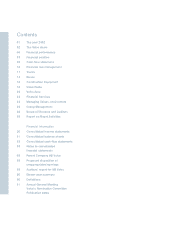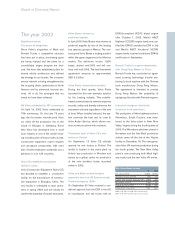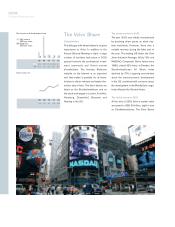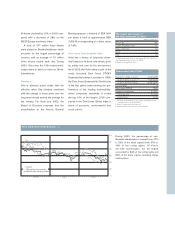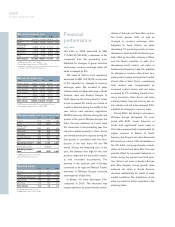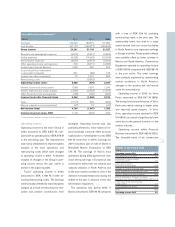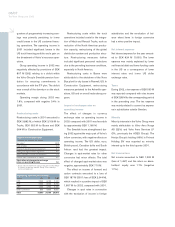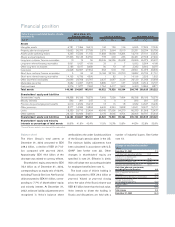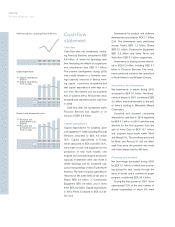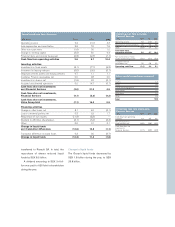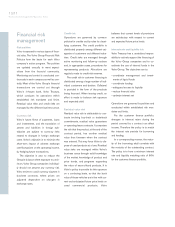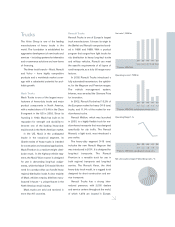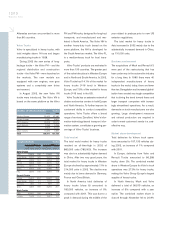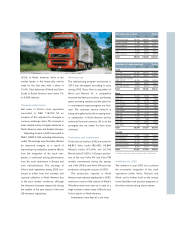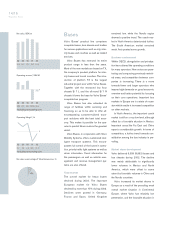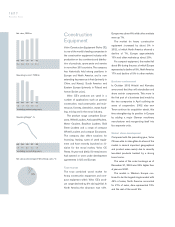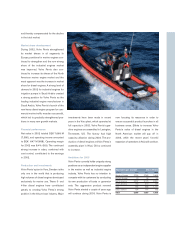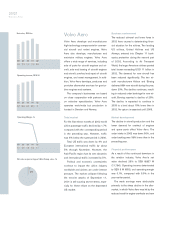Volvo 2002 Annual Report Download - page 12
Download and view the complete annual report
Please find page 12 of the 2002 Volvo annual report below. You can navigate through the pages in the report by either clicking on the pages listed below, or by using the keyword search tool below to find specific information within the annual report.
10/11
Financial risk management/Business Areas
Financial risk
management
Risk policies
Volvo is exposed to various types of finan-
cial risks. The Volvo Group Financial Risk
Policies form the basis for each Volvo
company’s action program. The policies
are updated annually to meet expect-
ations from the financial community.
Monitoring and control is conducted con-
tinuously in each company as well as cen-
trally. Most of the Volvo Group’s financial
transactions are carried out through
Volvo’s in-house bank, Volvo Treasury,
which conducts its operations within
established risk mandates and limits.
Residual value risks and credit risks are
managed by the different business areas.
Currency risk
Volvo’s future flows of payments, loans
and investments, and the translation of
assets and liabilities in foreign sub-
sidiaries are subject to currency risks
related to changes in foreign exchange
rates. Volvo’s objective is to minimize the
short-term impact of adverse exchange
rate fluctuations on the operating income,
by hedging future transactions.
The objective is also to reduce the
Group’s balance sheet exposure to a min-
imum. Volvo Group companies individual-
ly should not assume any currency risk.
Volvo strives to avoid currency clauses in
business contracts, where prices are
adjusted dependent on changes in
exchange rates.
Credit risk
Operations are governed by common
policies for credits and by rules for classi-
fying customers. The credit portfolio is
distributed properly among different cat-
egories of customers and different indus-
tries. Credit risks are managed through
active monitoring and follow-up routines
and, in appropriate cases, procedures for
repossessing products. Allocations are
regularly made to credit-risk reserves.
The credit risk in customer financing is
distributed among a large number of indi-
vidual customers and dealers. Collateral
is provided in the form of the products
being financed. When issuing credit, an
effort is made to balance risk exposure
and expected yield.
Residual-value risk
Residual value risk is attributable to con-
tracts involving buy-back or trade-back
commitments, residual value guarantees
or operating lease contracts. It comprises
the risk that the product, at the end of the
contract period, has another residual
value than foreseen when the contract
was entered. This may force Volvo to dis-
pose of used products at a loss. Residual
value risks are managed within Volvo’s
business areas through solid knowledge
of the market, knowledge of product and
price trends, and programs supporting
the value of second-hand products. It is
Volvo’s policy to provide for this exposure
on a continuing basis, so that the book
value of these vehicles are in line with cur-
rent and anticipated future price levels on
used commercial products. Volvo
believes that current levels of provisions
are satisfactory with respect to current
and expected future price levels.
Interest-rate and liquidity risk
Volvo Treasury has a centralized respon-
sibility to actively support the financing of
the Volvo Group companies and to co-
ordinate the use of internal funds in the
Volvo Group. The objectives are to:
•coordinate management and invest-
ments of liquid funds
•coordinate funding
•safeguard access to liquidity
•reduce financial risks
•optimize interest net
Operations are governed by policies and
conducted within established risk man-
dates and limits.
For the customer finance portfolio,
changes in interest rates during the
period covered by a contract can affect
income. Therefore the policy is to match
the interest rate periods for borrowing
and lending.
In a corresponding manner, the matur-
ity of the borrowing shall correlate with
the maturity of the outstanding contract.
The policy is to have a minimum interest
rate and liquidity matching ratio of 80%
for the customer finance portfolio.


